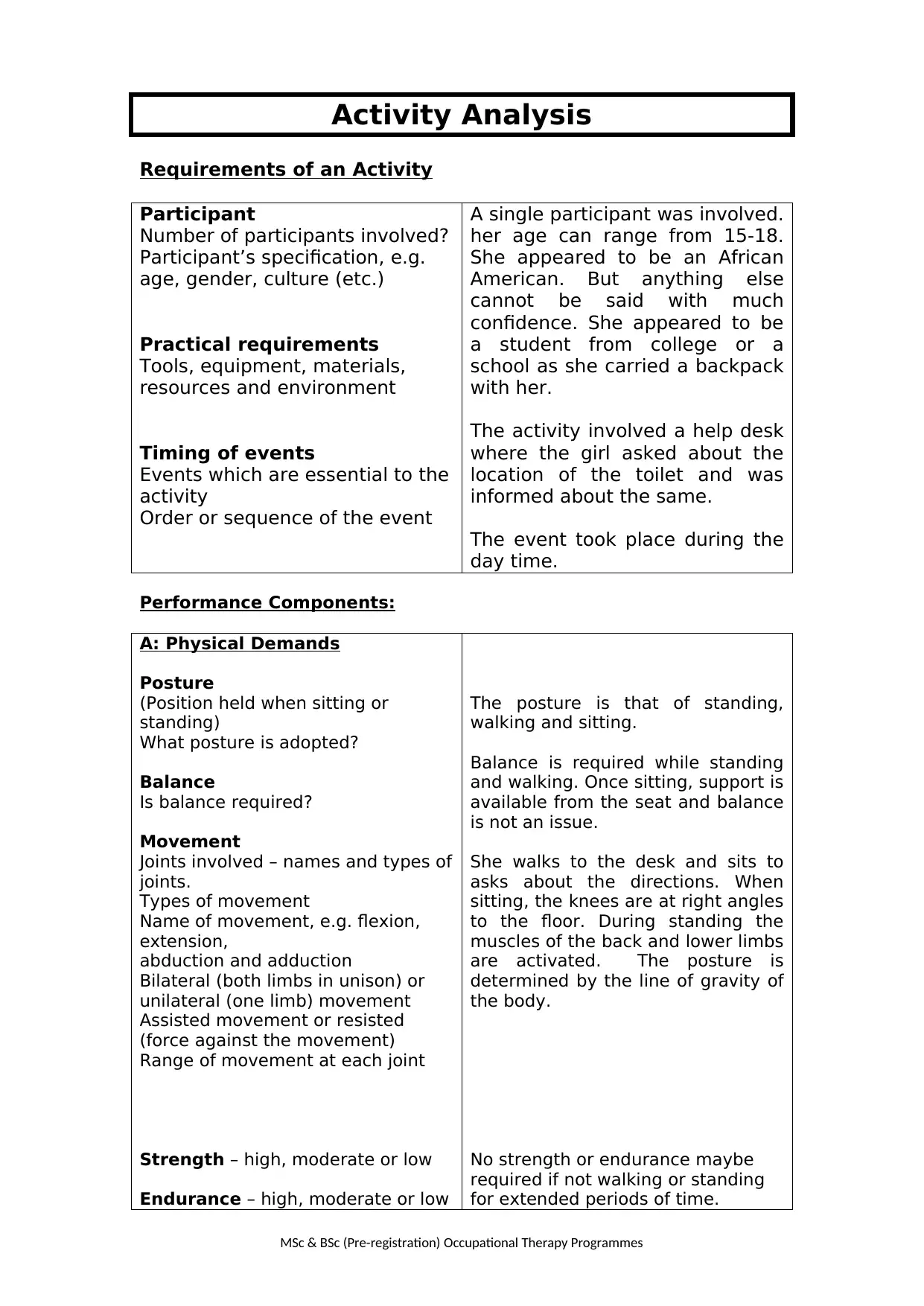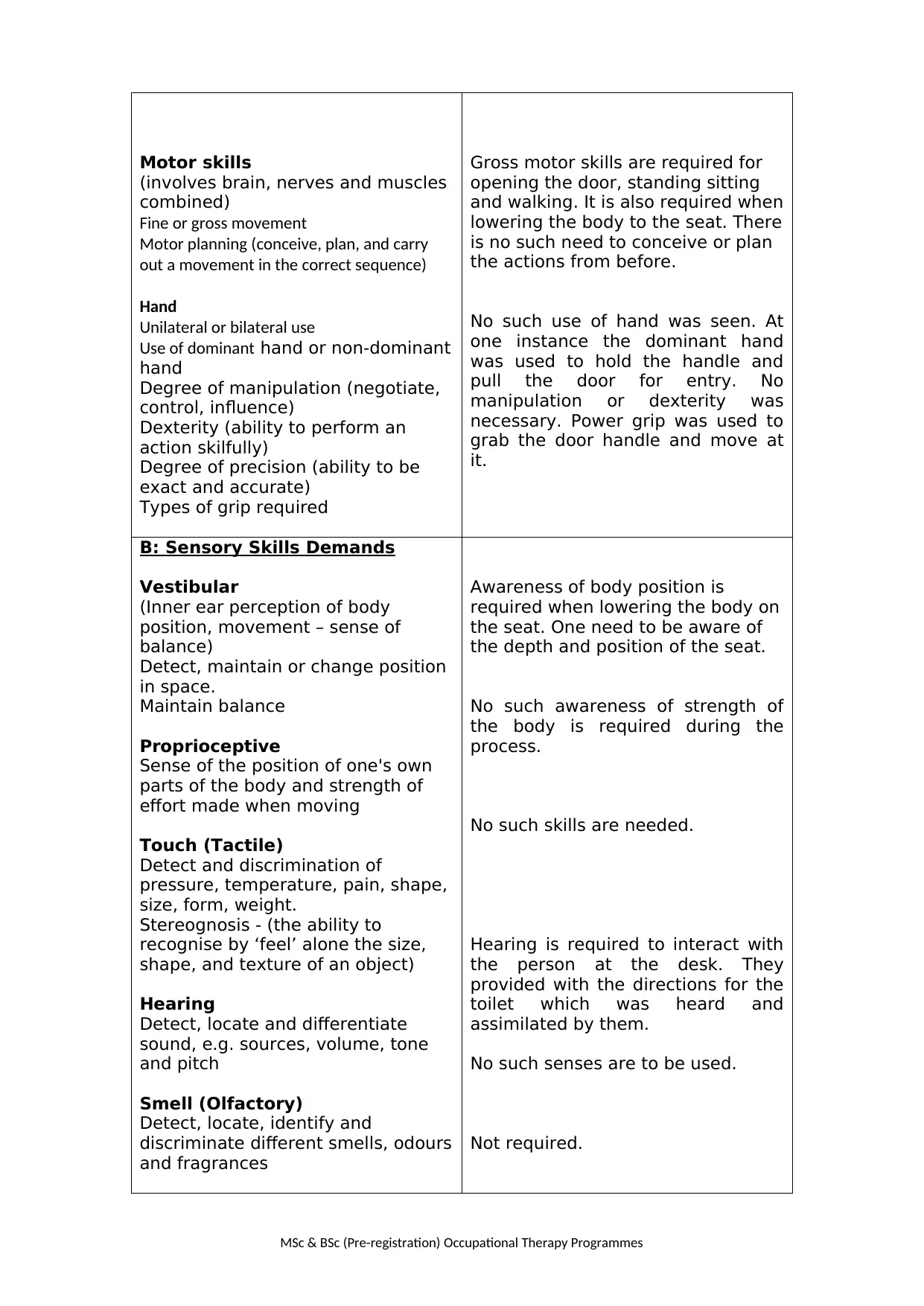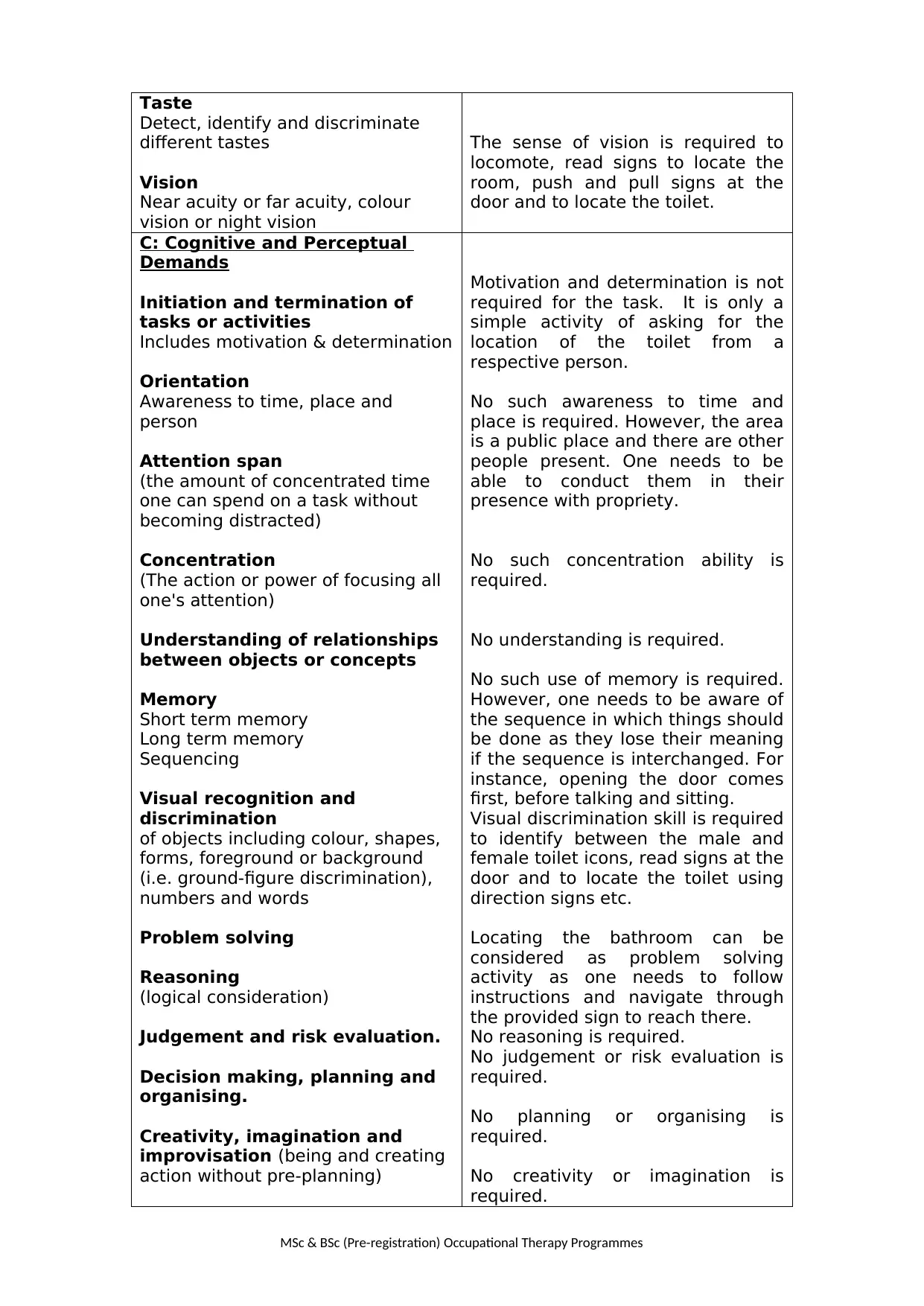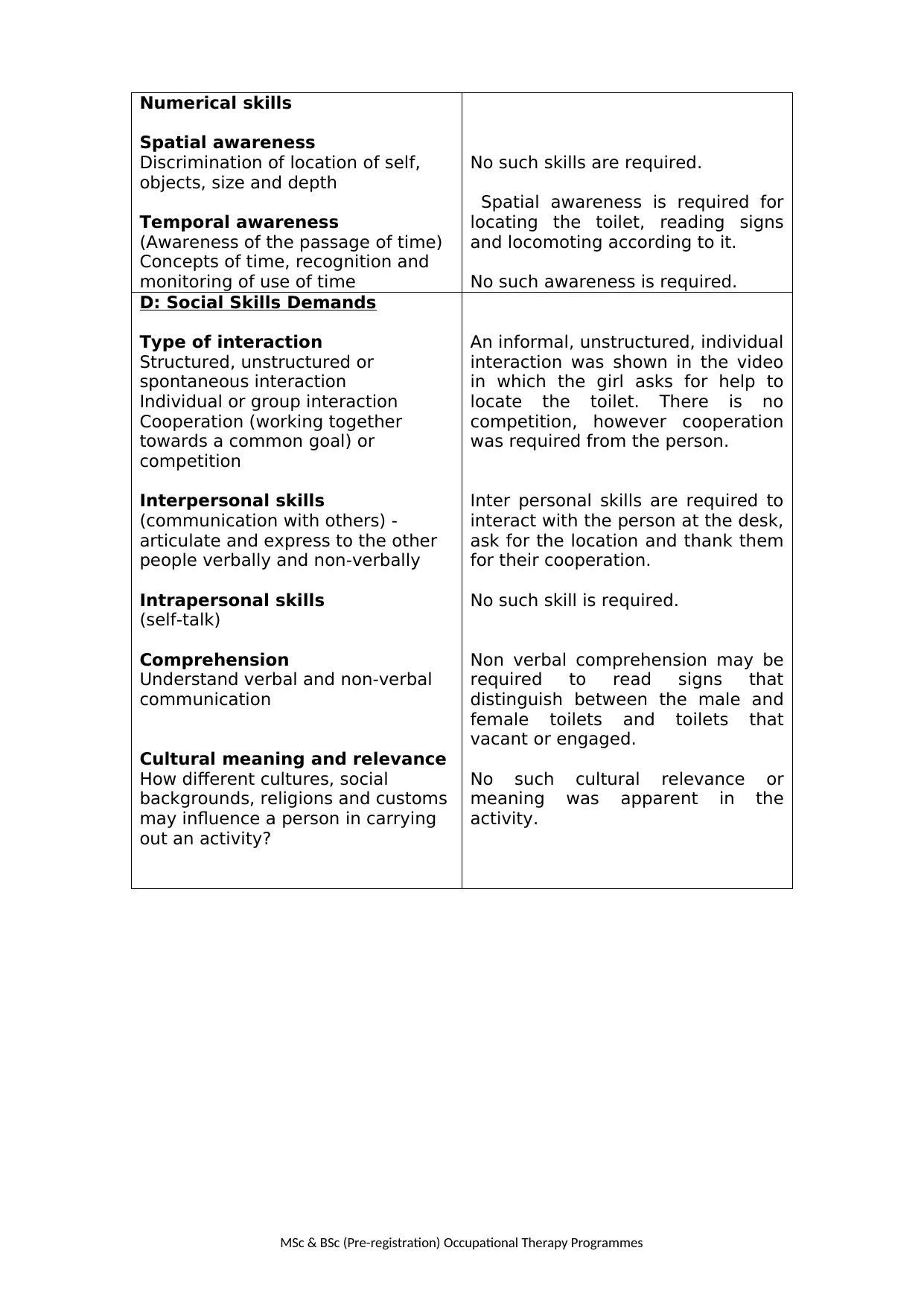Activity Analysis of Toilet Use: Occupational Therapy Report
VerifiedAdded on 2022/09/23
|4
|1372
|38
Report
AI Summary
This report presents an activity analysis focusing on the requirements of using a toilet, examining various performance components. It details the physical demands, including posture, balance, movement, strength, and motor skills, highlighting joint involvement and types of movement. Sensory skills, such as vestibular, proprioceptive, touch, hearing, and vision are analyzed in relation to the activity. Cognitive and perceptual demands, including initiation, attention, memory, and problem-solving, are assessed. Finally, the report evaluates the social skills involved, such as interaction types and interpersonal skills, providing a comprehensive overview of the activity's requirements. The analysis considers a scenario where a person asks for directions to the toilet and the subsequent process of using the toilet.

Activity Analysis
Requirements of an Activity
Participant
Number of participants involved?
Participant’s specification, e.g.
age, gender, culture (etc.)
Practical requirements
Tools, equipment, materials,
resources and environment
Timing of events
Events which are essential to the
activity
Order or sequence of the event
A single participant was involved.
her age can range from 15-18.
She appeared to be an African
American. But anything else
cannot be said with much
confidence. She appeared to be
a student from college or a
school as she carried a backpack
with her.
The activity involved a help desk
where the girl asked about the
location of the toilet and was
informed about the same.
The event took place during the
day time.
Performance Components:
A: Physical Demands
Posture
(Position held when sitting or
standing)
What posture is adopted?
Balance
Is balance required?
Movement
Joints involved – names and types of
joints.
Types of movement
Name of movement, e.g. flexion,
extension,
abduction and adduction
Bilateral (both limbs in unison) or
unilateral (one limb) movement
Assisted movement or resisted
(force against the movement)
Range of movement at each joint
Strength – high, moderate or low
Endurance – high, moderate or low
The posture is that of standing,
walking and sitting.
Balance is required while standing
and walking. Once sitting, support is
available from the seat and balance
is not an issue.
She walks to the desk and sits to
asks about the directions. When
sitting, the knees are at right angles
to the floor. During standing the
muscles of the back and lower limbs
are activated. The posture is
determined by the line of gravity of
the body.
No strength or endurance maybe
required if not walking or standing
for extended periods of time.
MSc & BSc (Pre-registration) Occupational Therapy Programmes
Requirements of an Activity
Participant
Number of participants involved?
Participant’s specification, e.g.
age, gender, culture (etc.)
Practical requirements
Tools, equipment, materials,
resources and environment
Timing of events
Events which are essential to the
activity
Order or sequence of the event
A single participant was involved.
her age can range from 15-18.
She appeared to be an African
American. But anything else
cannot be said with much
confidence. She appeared to be
a student from college or a
school as she carried a backpack
with her.
The activity involved a help desk
where the girl asked about the
location of the toilet and was
informed about the same.
The event took place during the
day time.
Performance Components:
A: Physical Demands
Posture
(Position held when sitting or
standing)
What posture is adopted?
Balance
Is balance required?
Movement
Joints involved – names and types of
joints.
Types of movement
Name of movement, e.g. flexion,
extension,
abduction and adduction
Bilateral (both limbs in unison) or
unilateral (one limb) movement
Assisted movement or resisted
(force against the movement)
Range of movement at each joint
Strength – high, moderate or low
Endurance – high, moderate or low
The posture is that of standing,
walking and sitting.
Balance is required while standing
and walking. Once sitting, support is
available from the seat and balance
is not an issue.
She walks to the desk and sits to
asks about the directions. When
sitting, the knees are at right angles
to the floor. During standing the
muscles of the back and lower limbs
are activated. The posture is
determined by the line of gravity of
the body.
No strength or endurance maybe
required if not walking or standing
for extended periods of time.
MSc & BSc (Pre-registration) Occupational Therapy Programmes
Paraphrase This Document
Need a fresh take? Get an instant paraphrase of this document with our AI Paraphraser

Motor skills
(involves brain, nerves and muscles
combined)
Fine or gross movement
Motor planning (conceive, plan, and carry
out a movement in the correct sequence)
Hand
Unilateral or bilateral use
Use of dominant hand or non-dominant
hand
Degree of manipulation (negotiate,
control, influence)
Dexterity (ability to perform an
action skilfully)
Degree of precision (ability to be
exact and accurate)
Types of grip required
Gross motor skills are required for
opening the door, standing sitting
and walking. It is also required when
lowering the body to the seat. There
is no such need to conceive or plan
the actions from before.
No such use of hand was seen. At
one instance the dominant hand
was used to hold the handle and
pull the door for entry. No
manipulation or dexterity was
necessary. Power grip was used to
grab the door handle and move at
it.
B: Sensory Skills Demands
Vestibular
(Inner ear perception of body
position, movement – sense of
balance)
Detect, maintain or change position
in space.
Maintain balance
Proprioceptive
Sense of the position of one's own
parts of the body and strength of
effort made when moving
Touch (Tactile)
Detect and discrimination of
pressure, temperature, pain, shape,
size, form, weight.
Stereognosis - (the ability to
recognise by ‘feel’ alone the size,
shape, and texture of an object)
Hearing
Detect, locate and differentiate
sound, e.g. sources, volume, tone
and pitch
Smell (Olfactory)
Detect, locate, identify and
discriminate different smells, odours
and fragrances
Awareness of body position is
required when lowering the body on
the seat. One need to be aware of
the depth and position of the seat.
No such awareness of strength of
the body is required during the
process.
No such skills are needed.
Hearing is required to interact with
the person at the desk. They
provided with the directions for the
toilet which was heard and
assimilated by them.
No such senses are to be used.
Not required.
MSc & BSc (Pre-registration) Occupational Therapy Programmes
(involves brain, nerves and muscles
combined)
Fine or gross movement
Motor planning (conceive, plan, and carry
out a movement in the correct sequence)
Hand
Unilateral or bilateral use
Use of dominant hand or non-dominant
hand
Degree of manipulation (negotiate,
control, influence)
Dexterity (ability to perform an
action skilfully)
Degree of precision (ability to be
exact and accurate)
Types of grip required
Gross motor skills are required for
opening the door, standing sitting
and walking. It is also required when
lowering the body to the seat. There
is no such need to conceive or plan
the actions from before.
No such use of hand was seen. At
one instance the dominant hand
was used to hold the handle and
pull the door for entry. No
manipulation or dexterity was
necessary. Power grip was used to
grab the door handle and move at
it.
B: Sensory Skills Demands
Vestibular
(Inner ear perception of body
position, movement – sense of
balance)
Detect, maintain or change position
in space.
Maintain balance
Proprioceptive
Sense of the position of one's own
parts of the body and strength of
effort made when moving
Touch (Tactile)
Detect and discrimination of
pressure, temperature, pain, shape,
size, form, weight.
Stereognosis - (the ability to
recognise by ‘feel’ alone the size,
shape, and texture of an object)
Hearing
Detect, locate and differentiate
sound, e.g. sources, volume, tone
and pitch
Smell (Olfactory)
Detect, locate, identify and
discriminate different smells, odours
and fragrances
Awareness of body position is
required when lowering the body on
the seat. One need to be aware of
the depth and position of the seat.
No such awareness of strength of
the body is required during the
process.
No such skills are needed.
Hearing is required to interact with
the person at the desk. They
provided with the directions for the
toilet which was heard and
assimilated by them.
No such senses are to be used.
Not required.
MSc & BSc (Pre-registration) Occupational Therapy Programmes

Taste
Detect, identify and discriminate
different tastes
Vision
Near acuity or far acuity, colour
vision or night vision
The sense of vision is required to
locomote, read signs to locate the
room, push and pull signs at the
door and to locate the toilet.
C: Cognitive and Perceptual
Demands
Initiation and termination of
tasks or activities
Includes motivation & determination
Orientation
Awareness to time, place and
person
Attention span
(the amount of concentrated time
one can spend on a task without
becoming distracted)
Concentration
(The action or power of focusing all
one's attention)
Understanding of relationships
between objects or concepts
Memory
Short term memory
Long term memory
Sequencing
Visual recognition and
discrimination
of objects including colour, shapes,
forms, foreground or background
(i.e. ground-figure discrimination),
numbers and words
Problem solving
Reasoning
(logical consideration)
Judgement and risk evaluation.
Decision making, planning and
organising.
Creativity, imagination and
improvisation (being and creating
action without pre-planning)
Motivation and determination is not
required for the task. It is only a
simple activity of asking for the
location of the toilet from a
respective person.
No such awareness to time and
place is required. However, the area
is a public place and there are other
people present. One needs to be
able to conduct them in their
presence with propriety.
No such concentration ability is
required.
No understanding is required.
No such use of memory is required.
However, one needs to be aware of
the sequence in which things should
be done as they lose their meaning
if the sequence is interchanged. For
instance, opening the door comes
first, before talking and sitting.
Visual discrimination skill is required
to identify between the male and
female toilet icons, read signs at the
door and to locate the toilet using
direction signs etc.
Locating the bathroom can be
considered as problem solving
activity as one needs to follow
instructions and navigate through
the provided sign to reach there.
No reasoning is required.
No judgement or risk evaluation is
required.
No planning or organising is
required.
No creativity or imagination is
required.
MSc & BSc (Pre-registration) Occupational Therapy Programmes
Detect, identify and discriminate
different tastes
Vision
Near acuity or far acuity, colour
vision or night vision
The sense of vision is required to
locomote, read signs to locate the
room, push and pull signs at the
door and to locate the toilet.
C: Cognitive and Perceptual
Demands
Initiation and termination of
tasks or activities
Includes motivation & determination
Orientation
Awareness to time, place and
person
Attention span
(the amount of concentrated time
one can spend on a task without
becoming distracted)
Concentration
(The action or power of focusing all
one's attention)
Understanding of relationships
between objects or concepts
Memory
Short term memory
Long term memory
Sequencing
Visual recognition and
discrimination
of objects including colour, shapes,
forms, foreground or background
(i.e. ground-figure discrimination),
numbers and words
Problem solving
Reasoning
(logical consideration)
Judgement and risk evaluation.
Decision making, planning and
organising.
Creativity, imagination and
improvisation (being and creating
action without pre-planning)
Motivation and determination is not
required for the task. It is only a
simple activity of asking for the
location of the toilet from a
respective person.
No such awareness to time and
place is required. However, the area
is a public place and there are other
people present. One needs to be
able to conduct them in their
presence with propriety.
No such concentration ability is
required.
No understanding is required.
No such use of memory is required.
However, one needs to be aware of
the sequence in which things should
be done as they lose their meaning
if the sequence is interchanged. For
instance, opening the door comes
first, before talking and sitting.
Visual discrimination skill is required
to identify between the male and
female toilet icons, read signs at the
door and to locate the toilet using
direction signs etc.
Locating the bathroom can be
considered as problem solving
activity as one needs to follow
instructions and navigate through
the provided sign to reach there.
No reasoning is required.
No judgement or risk evaluation is
required.
No planning or organising is
required.
No creativity or imagination is
required.
MSc & BSc (Pre-registration) Occupational Therapy Programmes
⊘ This is a preview!⊘
Do you want full access?
Subscribe today to unlock all pages.

Trusted by 1+ million students worldwide

Numerical skills
Spatial awareness
Discrimination of location of self,
objects, size and depth
Temporal awareness
(Awareness of the passage of time)
Concepts of time, recognition and
monitoring of use of time
No such skills are required.
Spatial awareness is required for
locating the toilet, reading signs
and locomoting according to it.
No such awareness is required.
D: Social Skills Demands
Type of interaction
Structured, unstructured or
spontaneous interaction
Individual or group interaction
Cooperation (working together
towards a common goal) or
competition
Interpersonal skills
(communication with others) -
articulate and express to the other
people verbally and non-verbally
Intrapersonal skills
(self-talk)
Comprehension
Understand verbal and non-verbal
communication
Cultural meaning and relevance
How different cultures, social
backgrounds, religions and customs
may influence a person in carrying
out an activity?
An informal, unstructured, individual
interaction was shown in the video
in which the girl asks for help to
locate the toilet. There is no
competition, however cooperation
was required from the person.
Inter personal skills are required to
interact with the person at the desk,
ask for the location and thank them
for their cooperation.
No such skill is required.
Non verbal comprehension may be
required to read signs that
distinguish between the male and
female toilets and toilets that
vacant or engaged.
No such cultural relevance or
meaning was apparent in the
activity.
MSc & BSc (Pre-registration) Occupational Therapy Programmes
Spatial awareness
Discrimination of location of self,
objects, size and depth
Temporal awareness
(Awareness of the passage of time)
Concepts of time, recognition and
monitoring of use of time
No such skills are required.
Spatial awareness is required for
locating the toilet, reading signs
and locomoting according to it.
No such awareness is required.
D: Social Skills Demands
Type of interaction
Structured, unstructured or
spontaneous interaction
Individual or group interaction
Cooperation (working together
towards a common goal) or
competition
Interpersonal skills
(communication with others) -
articulate and express to the other
people verbally and non-verbally
Intrapersonal skills
(self-talk)
Comprehension
Understand verbal and non-verbal
communication
Cultural meaning and relevance
How different cultures, social
backgrounds, religions and customs
may influence a person in carrying
out an activity?
An informal, unstructured, individual
interaction was shown in the video
in which the girl asks for help to
locate the toilet. There is no
competition, however cooperation
was required from the person.
Inter personal skills are required to
interact with the person at the desk,
ask for the location and thank them
for their cooperation.
No such skill is required.
Non verbal comprehension may be
required to read signs that
distinguish between the male and
female toilets and toilets that
vacant or engaged.
No such cultural relevance or
meaning was apparent in the
activity.
MSc & BSc (Pre-registration) Occupational Therapy Programmes
1 out of 4
Your All-in-One AI-Powered Toolkit for Academic Success.
+13062052269
info@desklib.com
Available 24*7 on WhatsApp / Email
![[object Object]](/_next/static/media/star-bottom.7253800d.svg)
Unlock your academic potential
Copyright © 2020–2025 A2Z Services. All Rights Reserved. Developed and managed by ZUCOL.

